Physical Address
304 North Cardinal St.
Dorchester Center, MA 02124
Around the age of 2 years, children develop self-awareness, are able to recognize themselves in a mirror, and begin to utilize culturally-defined labels for self. From this point on, a child becomes increasingly capable of communicating his or her needs and desires through both visually emotive and lingual expressions. However, expression is a two-way street whereby, in addition to being able to express their own emotions, the ability to read the emotions of others is critical to successful communication and interaction. Indeed, perfecting the skills to both convey and decode emotions is paramount to success in the fields of politics, acting, leadership, and seduction.
Since time immemorial, artists and scientists alike have been fascinated with the human countenance and its features, beauty, and nuances of expression. It has been generally accepted that the eyes and the mouth are the principal tools of human expression, with the eyes being the dominant of the two. However, recent eye tracking studies suggest otherwise. When the observers were confronted by sad and angry facial expressions, their eyes more frequently focused on the eyes of those bearing those expressions, whereas fearful and neutral emotions channeled participants’ attention to both the eyes and the mouth. In contrast, smiling faces directed observers’ first fixation more likely and faster to the mouth region. , In contrast to these findings, Blais et al. found that the mouth area provided the most important cue across all static and dynamic facial expressions.
Suffice it to say, if the eyes are the windows to the soul, then the mouth is its door.
In light of the above, it is inexplicable that plastic surgeons have dedicated relatively little time to understanding and contributing to technical advances in aesthetic lip surgery. The perioral region is a measure of a person’s true age, perhaps more so than the neck and hands. Not only is it an age cue, but it is also a cornerstone of facial balance and beauty. Unfortunately, with most plastic surgeons, aesthetic lip surgery is merely an afterthought. Simply inflating lips that exhibit genetic or age-related dysmorphologies with the “latest and greatest” off-the-shelf filler or fat points to unfamiliarity with current lip-reshaping techniques, unfounded fear of scars, or concerns about causing more harm than good. Indeed, lip voluming in the presence of lip ptosis or another negative feature may actually accentuate the ptosis while promulgating a visual dissonance not normally found in nature. This chapter aims to bring clarification to LRS and to highlight it as a valuable addition to a plastic surgeon’s aesthetic armamentarium.
When planning for upper and lower lip enhancement, whether for rejuvenation or pure beautification purposes, follow the immutable rule “shape before volume,” just as when addressing a patient’s ptotic breast. In the same way that a breast becomes ptotic from the toll of physics, pregnancy, nursing, and time, the upper lip, corners of the mouth, and the lower lip sag due to incessant oral movement in concert with aging. Of course, the best solution is to tackle the pathogenesis of the problem in the first place (which is simply prevention), but currently our understanding of that is incomplete. The next best option is careful analysis to identify the factors contributing to the dysmorphology. In the previous examples, these factors are ptosis and possibly soft tissue involution. The solution for both the ptotic breast and the ptotic lip is surgical lifting, specifically appropriate mastopexy and lip lift, respectively. Once reshaping is factored in as the primary solution, then the decision to add volume at the same sitting can be mutually made with the patient.
Rejuvenation of the facial thirds has been traditionally thought of as a three-legged stool—tightening or lifting, resurfacing, and volume augmentation. Traditional and popularly performed tightening approaches include brow lift, blepharoplasty, and rhytidectomy. However, a face receiving all three of these surgeries, no matter how elegantly they were performed, will develop visual incongruence if the aging mouth is overlooked. Indeed, a senescent perioral region in a rejuvenated face will leave the face looking old, perhaps with even an unnaturally “operated” appearance. Other authors with lip-reshaping experience have also issued this caveat. , One can venture to say that complete facial rejuvenation is actually a stool with four legs—the fourth being shortening to reestablish the Vitruvian ratio or the “Golden Proportion” of youth. With aging comes global change in facial shape, from a short superiorly weighted oval to an elongated rectangle. In terms of facial beauty, it is agreed that the most important third is the lower third, spanning the area from the subnasale to the menton, , which, in turn, can be divided into a ratio of 30% upper lip (the ergotrid) and 70% lower lip/chin. Age alters this ratio closer to 1:1. Therefore to paint a convincing portrait of youth, these lower facial ratios should be reestablished. In so doing, it is helpful to consider the vertical dimension of the occlusal plane and its profound effect on the aesthetics of the overlying soft tissue. Patients should be made aware of significant abnormal deviations in their occlusal height before embarking on any LRS designed to improve their aesthetic ratios.
The periocular and perioral regions are the only anatomic areas that comprise two vertically aligned opposing structures (labium superius oris and labium inferius oris) defining a horizontal aperture. However, an attractive set of lips is not simply a symmetrical, good-looking upper unit situated above its identical counterpart below; the two bear distinctly different characteristics, yet they are in visual harmony in an aesthetically pleasing manner. Patients do not want to hear that they have a beautiful upper lip or a beautiful lower lip; they want to know that they have a beautiful set of lips. Plastic surgeons need to be more than just good furniture designers, so to speak; they must be good interior designers as well. By way of example, it is not good enough to just build a good-looking nose; this structure must be properly scaled to its immediate surroundings. Establishing harmonious proportions among morphologically distinct structures, in this case, the upper and lower lips, determines the crucial difference between a good result and an excellent one. For example, when planning an upper lip lift, it is essential to take into account the visual impact it would have in relation to the lower lip (interlabial harmony) as well as the rest of the face (labial–facial harmony).
What specifically makes a set of lips appealing? Although certain characteristics fall into and out of favor according to cultural standards popular at the time, some characteristics considered attractive are eternally immutable regardless of ethnic culture or vogue. Beautiful lips have the following characteristics:
The length of the ergotrid (the height of the area from the subnasale to the upper vermilion border) should be one half to one third the height of the area between the lower lip vermilion and the mentum. Alternatively, it should be equal in height to the distance from the supratarsal fold to the lower lid ciliary line.
Although 2 to 3 mm of upper incisor show is the traditional ideal, current fashion equates larger distances of 4 to 5 mm to a more vibrant and youthful look. In the male patient, 1 to 2 mm would be considered the ideal norm.
Conversely, lower incisor show should be minimal to absent, with the lower lip eclipsing them by sufficient superior positioning. Lower incisor show may suggest advanced age and/or aggression.
The upper vermilion height should be one third to one half the height of the lower lip, as measured at the midline.
Fullness of the lower lip should be confined to the middle third to half of its total transverse length.
The corners of the mouth should evoke a hint of superior angulation without flanking marionette folds.
Accentuated philtral columns that intimately flank a defined philtral dimple at their base punctuate the youthful ergotrid. The cutaneous lip surrounding the vermilion should be free of rhytides, and the vermilion itself should manifest subtle creases for a natural appearance. Unfortunately, it is all too common for younger patients to seek complete obliteration of these normal vermilion creases to conform to artificially idealized standards of beauty propagated by the mass media. Indeed, “fake is the new real”!
From the lateral view, the upper cutaneous lip should be short and exert a concave curvature, starting from the columellar base and ending with the pout of the vermilion border. Similarly, the lower lip should exhibit a slightly steep concavity from the sharp vermilion border to the labiomental groove. Indeed, the lower lip should have an almost hypotonic posture in its outward stance. However, there is a fine line between too much and too little, and this is dictated by both the practitioner’s and the patient’s aesthetic sensibilities.
Finally, the upper lip should protrude beyond the lower lip by approximately 1 to 2 mm. Excessive lower lip protrusion imparts a prognathous appearance equated with lower intelligence.
Fig. 37.1 A, B illustrates the previously mentioned characteristics of the ideal young mouth in both the anteroposterior and lateral views.
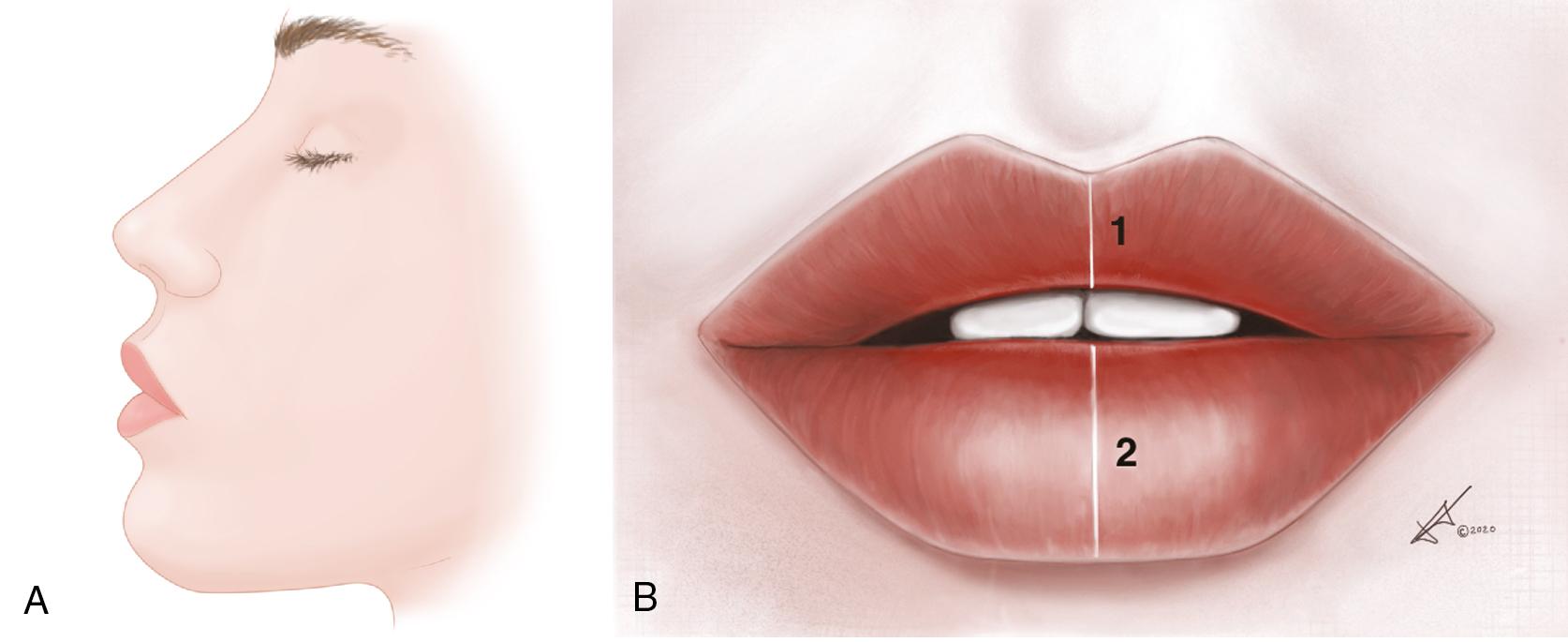
Specific changes occur in the perioral region with aging ( Fig. 37.2 ). The ergotrid becomes elongated, changing from a curved arch that emanates from the columellar base to a flat, straight-edged sheet, which, in turn, widens the oral aperture. The same aesthetic unit loses its youthful topography, including the “white roll,” philtral columns, and dimple. The oral commissures variably droop, and the lower lip becomes ptotic. Consequently, the lower lip vermilion arches inferiorly exposing the lower incisors. The lower lip not only becomes ptotic with age but generally everts forward in patients with some degree of microgenia. However, the opposite is true in those with normal to large-sized chins; in these individuals, the chin ages with ptotic inversion. Ironically, the older lower lip mirrors the characteristics of a youthful upper lip, with arching and associated dental show. Adding to this scenario is the gradual erosion of the bony support of the lips —the maxilla, the mandible, and their associated dentition. This causes inversion of both lips to varying degrees. As mentioned above, in the presence of microgenia, the lower lip tends to roll out in an exaggerated manner and consequently accentuates the labiomental groove. This situation arises from lack of vertically aligned chin support to the lower lip and can be exacerbated by the added weight of horizontally placed filler within the vermilion itself. Finally, the exterior fabric of the perioral region atrophies, manifesting as vermilion involution, thinner skin, and radial rhytides. Indeed, recent anatomic studies by Rohrich and Pessa. have documented the presence of both subcutaneous and submuscular fat deep to the orbicularis oris and mentalis. Both Rohrich et al. and Lambros and Amos. , have postulated that this volume loss is the etiologic factor in the age-related morphologic changes noted previously. However, the process is more complex than volume loss alone because the incessant perioral muscular contraction involved in eating, speaking, kissing, and voluntary and involuntary expressions is undoubtedly complicitous. The exact interplay between muscular activity and volume loss has yet to be determined.
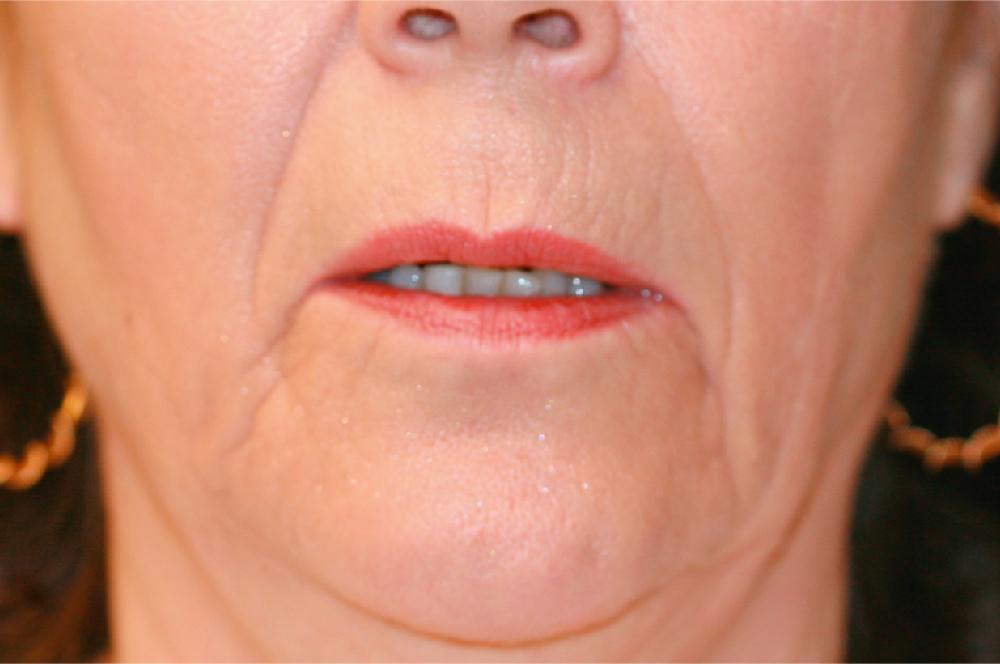
In addition to acquired age-related changes, the lips may exhibit congenital morphologic traits paralleling those of senescence. Specifically, a long ergotrid, commissural ptosis, and vermilion inversion may be encountered in the young patient ( Fig. 37.3 ), in time synergistically compounding the effects of age-acquired ones. However, a purely congenital trait is one which can be called labium apostrophus or apostrophe lip due to the resemblance to the punctuation symbol. This manifests as localized premature inversion of the lateral upper vermilion, most likely accompanied by some degree of commissural ptosis and perhaps a marionette fold. The apostrophe lip can be further characterized as positive, negative, or neutral, according to its flanking commissure being canted superiorly, inferiorly, or not at all, respectively.
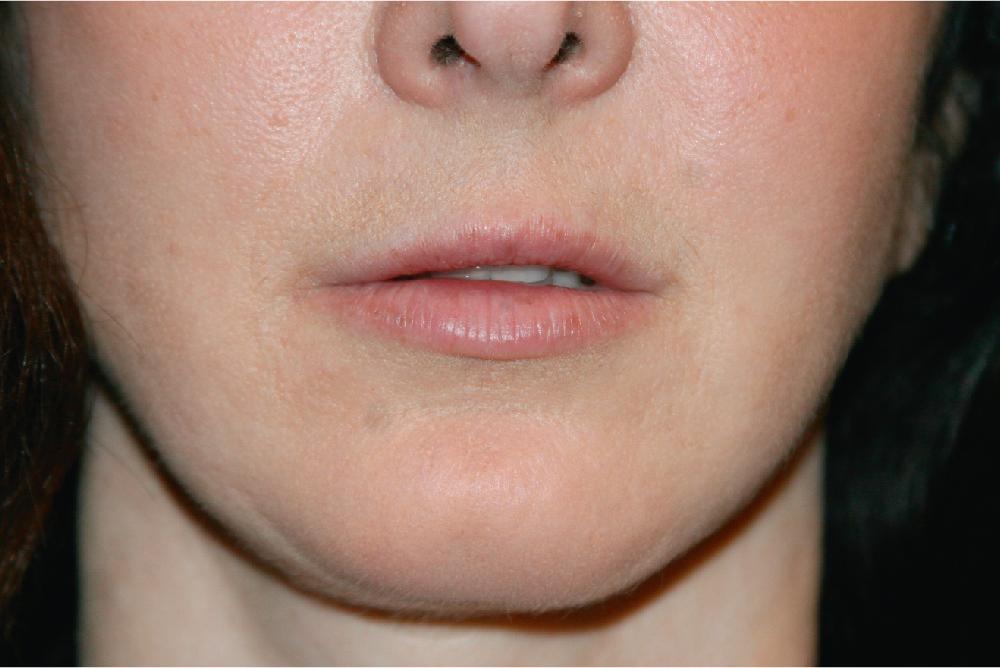
Of course, as with all aesthetic surgery, attaining good results in perioral surgery requires meticulous attention to detail in analysis, planning, and surgical performance. The ability of the surgeon to translate a shared aesthetic vision into physical visual harmony separates the merely good result from an excellent one. Specifically, in the field of lip reshaping, the surgeon should have an appreciation of not only the aesthetic interplay between the lips themselves but also their effect on the facial appearance as a whole.
Regardless of a surgeon’s particular style, the initial consult should revolve around a patient’s goals. It is helpful to have the patient bring a few photographs showing the type of lips they like, either photos obtained from the popular media or personal photographs taken in their younger years. Although it is a red flag whenever a patient presents an unsolicited dossier full of photographs of celebrities taken from all angles, a few can actually serve as a communication tool and give insight into a patient’s expectations concerning both the size and shape of lips. Based on experience, it is important to ensure realistic patient expectations to avoid subjective disappointment despite an objectively successful result from a technical standpoint. Surgeons should be quick to point out that photographs serve as inspiration only and that they cannot create an exact replica of an envied set of lips, but only their a version of such.
Most patients who seek cosmetic surgery are in relatively good health, so there are few medical contraindications to the process. However, this does not preclude performing a complete history and physical examination, with or without added input from the patient’s primary care physician, when appropriate. Relevant information to be gleaned during the initial consult includes a history of herpes simplex type 1 infection, connective tissue disease, diabetes, cheilitis, and ongoing orthodontic treatment, as well as past peri- or intraoral cancer, soft tissue injuries, surgery, and cosmetic filler injections. Surgeries, such as a rhinoplasty and chin augmentation or reduction (especially via an intraoral approach), may account for certain dysmorphologies encountered on examination.
Except perhaps male rhinoplasty and endoscopic midface lift, in no other operation does patient selection play such a critical role in a successful outcome. Despite an otherwise excellent physical result according to most objective measures, if the operation falls short of the patient’s purely subjective standard for success, it has essentially failed. Unfortunately, the patient’s emotional response to perceived failure of perioral surgery can exaggerate the minutest flaw that may have arisen. The reason for this lies in the deep-rooted psychosexual influence beautiful lips represent. Similar to a secondary sexual characteristic, the appearance of the lips represent youth, sensuality, and fertility. Therefore it is not surprising that lips with age-related changes, scar imperfections, asymmetries, disharmony, or simple hypoplasia may elicit counterproductive behavior stemming from subconscious insecurity over their perceived sexuality. Consequently, the stakes are high with LRS. Patients can experience great elation eclipsing that from any other surgery or can be “devastated” by the most minor of problems. Therefore patient selection is paramount to a successful result.
Similar to assessing the chin as well as the nose during a rhinoplasty consult, both lips should be assessed even if the patient has complaints regarding only one. As mentioned previously, both the upper and lower lips need to be harmonious in their proportions if optimal results are to be attained. Of course, it is up to the patient to make the final decision, but it is the surgeon’s responsibility to at least warn the patient of possible cosmetic shortcomings if an incomplete approach is adopted. To do this, the surgeon must be able to identify each age-related, idiopathic, and genetic dysmorphology contributing to the patient’s suboptimal perioral appearance.
As with all surgical endeavors, incomplete and erroneous diagnoses will lead to inferior outcomes in lip reshaping. With the upper lip, confusion may arise in certain circumstances. Sometimes a patient may complain of a long upper lip when, in fact, it is not. This situation may be encountered after a ptotic tip is corrected during rhinoplasty. The superior tip rotation can inadvertently unveil an upper lip of normal length but which was previously assumed by the patient to be shorter. Understandably, this patient equates the perceived increase in upper lip length as newly acquired and attributable to the rhinoplasty. Obviously, the solution to this unanticipated effect from a shortened nose would be a secondary rhinoplasty, not an upper lip lift. The problem does not necessarily stem from a poorly performed rhinoplasty but more so from inadequate preoperative discussion of trade-offs and expectations. As the internet has pervaded every aspect of our lives, it is not surprising that patients acquire a huge amount of information and yet possibly are misguided about plastic surgery outcomes. In this regard, during the preoperative consultation, it is wise to not only explain the direct results of surgery but also convey its possible indirect effects. In the case of a rhinoplasty, the latter would include a discussion about how the visual interplay between the nose and its surrounding facial features (e.g., the lips) would change as a result of the surgery. Computer imaging may help in this regard.
Sometimes a patient may complain of an long upper lip even though it’s central portion is short. In these cases the perceived elongation is actually due to lateral flanking elements of the upper lip which appear long in relation to its central portion. The actual cause of lateral elongation is the paucity of any visible lateral upper lip vermilion, a defining characteristic of the apostrophe lip itself. Complicating matters, this dysmorphology can be excerbated by a negative axis of the vermilion border. Consequently, a medialized corner lip lift is indicated over an upper lip lift because it is a more direct approach providing better control of shape ( Fig. 37.4 A, B). Since the problem lies not along the superior edge of the ergotrid but along it’s inferior edge, simply performing a wider excision at the lateral poles of a “bullhorn” upper lip lift in an attempt to correct the labrum apostrophus can be a futile exercise with diminishing returns and added complications ( Fig. 37.5 ).
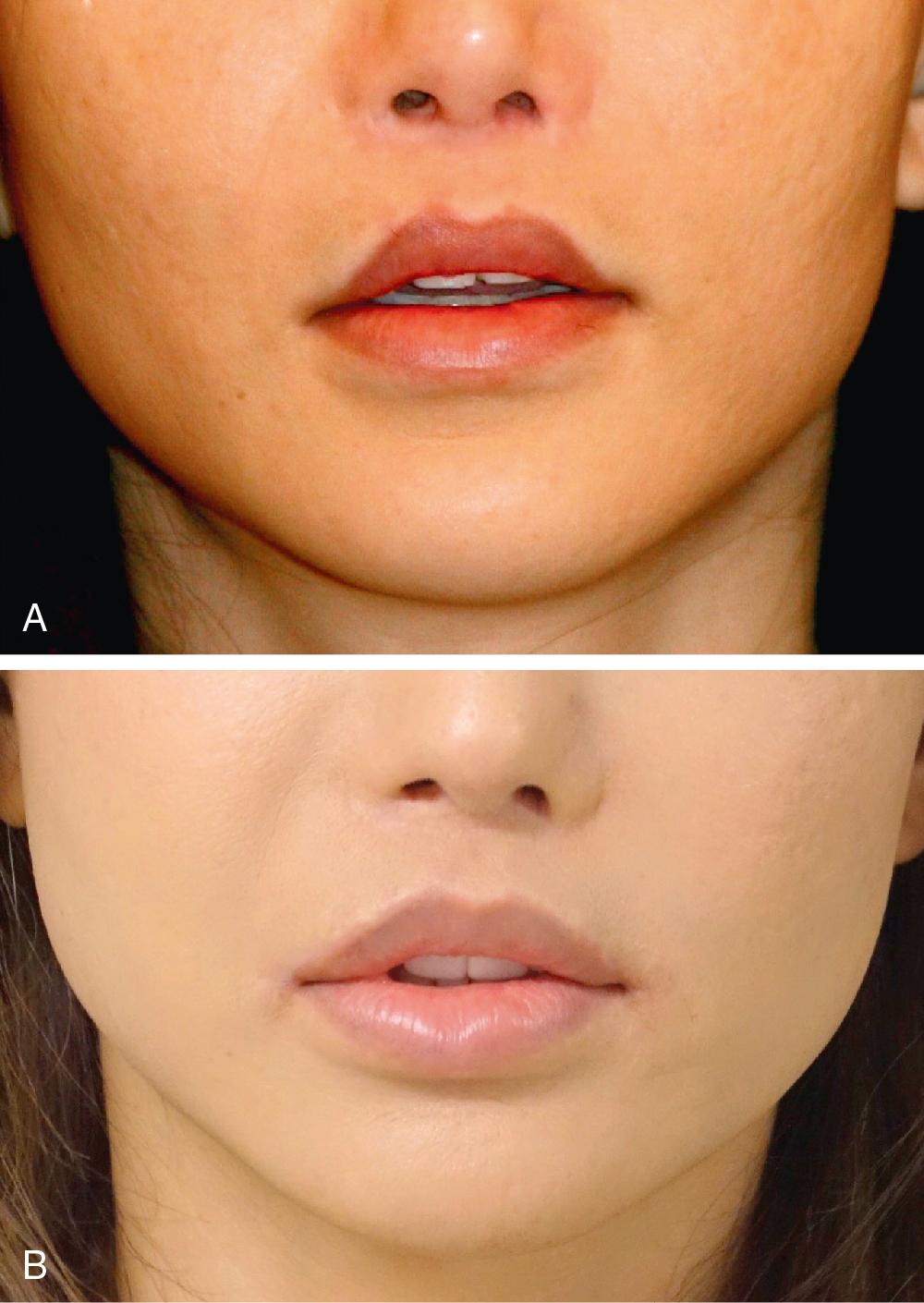
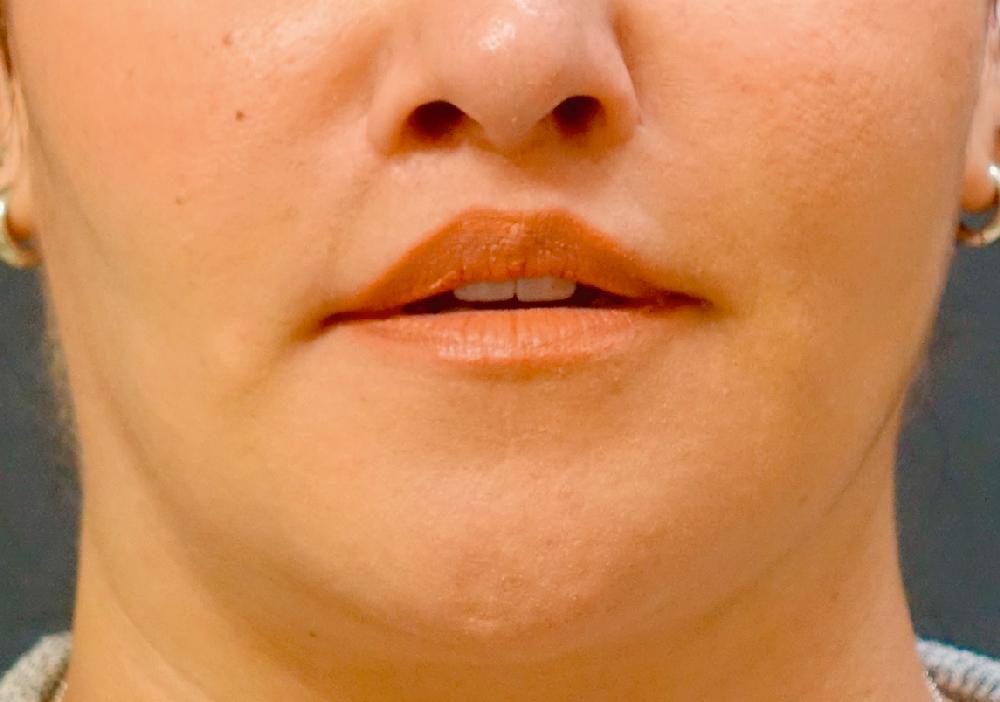
The length of the maxilla and the actual length of the upper incisors must be considered when evaluating the upper lip. This will have a bearing on the amount of upper incisor exposure a patient may expect from an upper lip lift. Obviously, those with a short maxilla and/or short upper incisors should be counseled about expectations from an upper lip lift, if it is indicated at all. Instead, these patients should be referred to a dentist and/or maxillofacial specialist before embarking on any lip-reshaping surgery.
When it comes to the lower lip, the chin should also be assessed. The subjacent bony chin and musculature significantly influence the lower lip’s stance, in such a way that the chin and the lower lip is a complex that should be addressed together. The position of the chin in relation to the overlying lower lip can determine whether the lower lip everts or inverts. Specifically, the more the chin is recessed, the more the lower lip will fall forward in a hypotonic and flaccid way, exacerbating lower incisor show. This can be explained by the abnormal posterior position of the labiomental junction, or “root” of the lower lip, which acts as a tether to encourage excessive inferior protrusion of the labium inferius ( Fig. 37.6 A–D). Accompanying findings include “cobblestoning” of the chin from subconscious mentalis contraction (which reflects the added effort to close the lips) and exaggeration of prejowl sulci. In contrast, the more the chin protrudes, the likelier it is that the lower lip will be inverted. The aging process only magnifies these problems. As indicated, chin augmentation should be proposed not only to improve the profile of the lower jaw but also to provide vertically aligned support to the lower lip; indeed, it should be part of the evaluation for LRS.
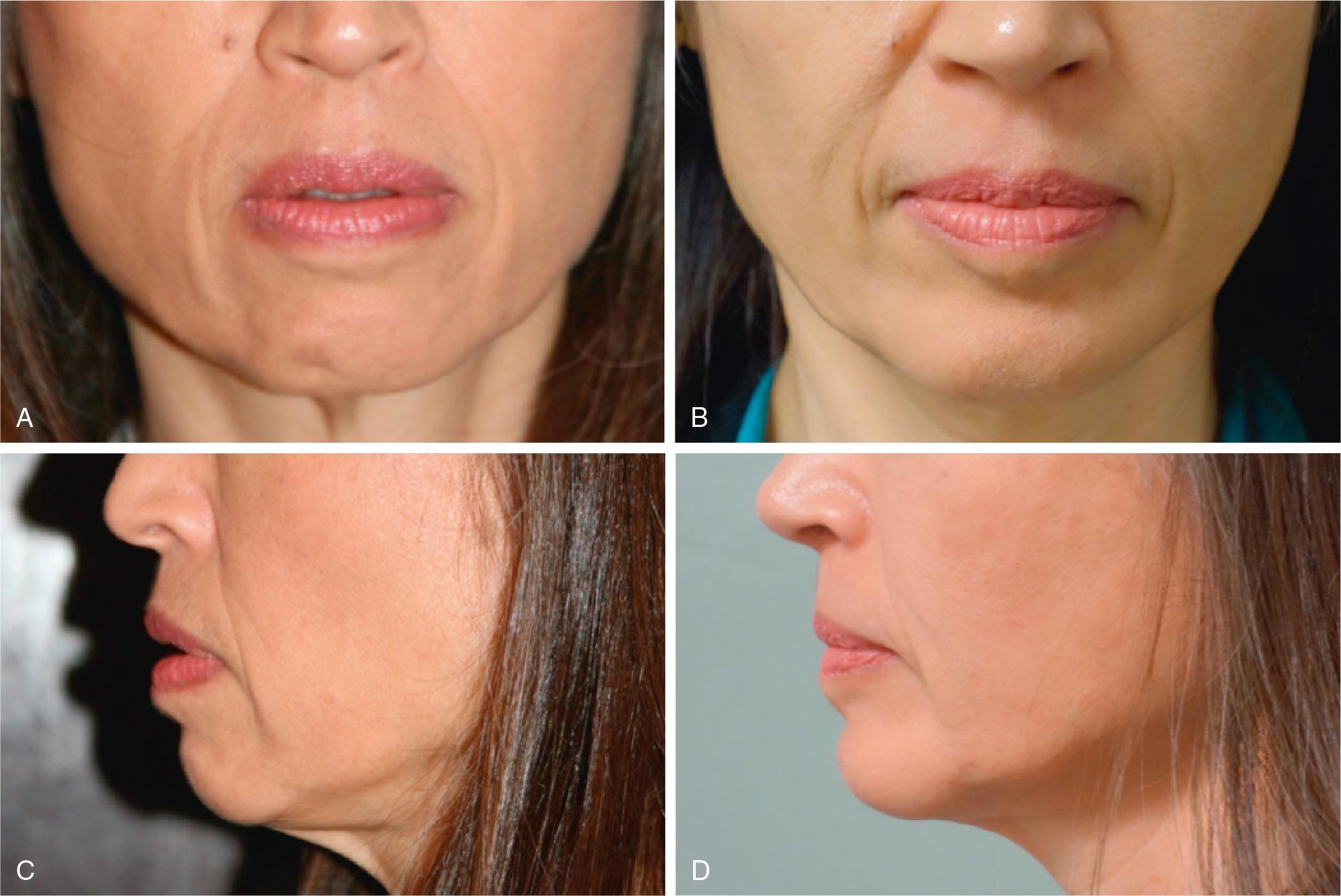
Needless to say, ensuring a patient’s overall health before surgery is the responsibility of the surgeon. This can be done with an assigned primary care physician to obtain a full set of laboratory results for anyone undergoing anesthesia and to get a formal medical clearance for those older than 45 years of age or for those who are younger if they have a significant medical condition.
The perioral region needs to be assessed in both anteroposterior and lateral views. Examination should focus not only on shape and symmetry but also on the influence of the envisioned result on the countenance as a whole. In this regard, examination with and without loupes is helpful, with the lips both lightly closed and open in repose to assess exposure of the upper and lower incisors. If scars are present, they should be analyzed in terms of appearance as well as pliability. Evidence of past cosmetic procedures, including resurfacing and filler injections, should be documented. Generally, plastic surgeons while planning surgery fall into two groups: those who rely on absolute measures and lengths and those who rely more on an innate aesthetic sense of form and balance. Although both approaches have distinct advantages and disadvantages, it is still important to refer to the long-accepted idealized dimensions, not as absolutes but merely as suggestions.
Perioral examination should start with the bony foundation of the lips, specifically, an assessment of dentition and occlusion. Significant variations from the norm will negatively affect the appearance of the lips and the overlying areas of the face. Any deviation in upper cutaneous lip length from idealized aesthetic proportions should be evaluated, including upper incisor exposure. Attention should be paid to subtle asymmetries along the width of the visible vermilion, including its thickness and degree of inversion. The cutaneous upper lip should be evaluated for radial rhytides, along with the topography of both the philtral columns and the vermilion border. The region around the commissures should be analyzed for corner lip ptosis, marionette folding, and localized upper lateral vermilion inversion (“apostrophe lip”). Each of these features play a part in determining which of the three types of corner lip lift should be performed.
As part of a comprehensive approach to lip reshaping, the lower lip should be evaluated in addition to the upper lip. Sagging of the lower lip occurs relatively early in life; it generally appears in the mid-20s, and one of its pathognomonic signs is lower incisor show. This is clearly exacerbated by the added weight of injected fillers, especially when accompanied by microgenia or retrognathia. In this regard, lower lip ptosis, lower incisor exposure, and the chin should be all be assessed. Analysis should also include vermilion thickness and whether the labium inferius is everted or inverted.
For all plastic surgery, photographs with consistent lighting serve not only as a two-dimensional complement to the three-dimensional examination but also as documentation for medical-legal purposes. Additionally, their two-dimensional nature can more objectively convey to the actual patient any preexisting asymmetries. These should include a basal view to document any columellar deviation, photographs of the lips in repose and slightly parted to reveal the dental backdrop, and photographs of the mouth with various expressions.
If the patient is edentulous, radiographs of the maxilla and the mandible should be taken to document the degree of bone erosion, and treatment should be coordinated with a dentist and maxillofacial surgeon. X-rays of the skull should also be obtained when consulting a patient with either long face syndrome or short face syndrome.
With aesthetic lip surgery, each of the previously mentioned dysmorphologies can be corrected with an individualized direct surgical method. The mere presence of any of these dysmorphologies in a healthy patient with realistic expectations is an indication to perform the appropriate operation.
However, a patient with unrealistic expectations is a major contraindication to proceeding with lip reshaping, possibly even more so than with any other aesthetic surgery. Many patients obsess over ostensibly trivial imperfections in scars, changes in the nares, and negligible asymmetries that normally go unnoticed by most others. The reason for this stems from the deep-rooted psychosexual nature of the lips themselves—not only do they reflect the beauty of youth but also impart a subtext of fertile sexuality similar to a secondary sexual characteristic. Lips manifesting age-related changes, asymmetries, disharmony, scar imperfections, or simple hypoplasia may foster counterproductive patient behavior stemming from subconscious sexual insecurity.
Poor health, including diabetes and certain autoimmune, connective tissue, and collagen vascular diseases, serves as a relative contraindication to this subfield of surgery. Patients undergoing orthodontia should have lip reshaping postponed until treatment is complete (because changing dental angulation significantly affects the overlying lips). Similar reasoning dictates that edentulous patients have any lip reshaping postponed until their dental reconstruction is completed.
Once the patient’s goals are determined and candidacy for perioral surgery is confirmed, the operative strategy must be formulated and explained to the patient. It must be remembered that certain lip-reshaping operations are associated with longer healing times and therefore impact the patient’s social reintegration. Indeed, when performed in conjunction with other facial procedures, such as rhytidectomy or rhinoplasty, often the lip surgery is more responsible for the prolonged return to normal activities. The patient should be made aware of this so they may schedule their life accordingly.
As previously discussed, adopting a more global approach to lip beautification surgery will not only lead to better visual congruency between the upper and lower lips but also with the face as a whole. Conceiving the final operative plan is simply applying logic to translate aesthetic sensibility from expectation to reality. Although the process involves aligning each lip dysmorphology with its corresponding corrective procedure, simply relying on such a “color by numbers” approach will lead to robotic results. It is generally agreed that plastic surgery is a form of art, and therefore we should take pride in imbuing our work with a passionate aesthetic sensibility. Like the artist, the plastic surgeon starts with a vision and must know how to manipulate the medium with the available tools and techniques. In the perioral reshaping armamentarium are techniques that modify the upper lips, the corners of the mouth, and the lower lips; all share the underlying premise of elevation. A surgical plan to hypothetically correct individual lip dysmorphologies is illustrated by Fig. 37.7 . An overview of the LRS decision algorithm can be seen in Fig. 37.8 .
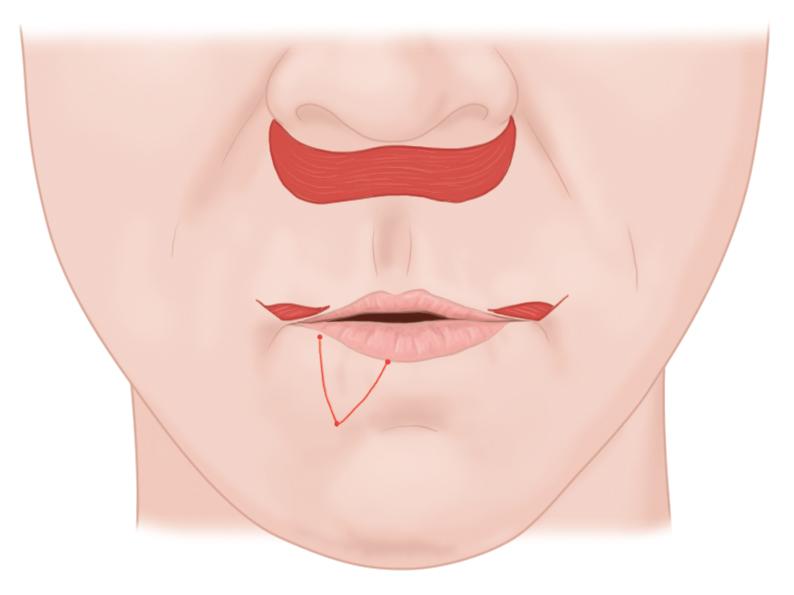
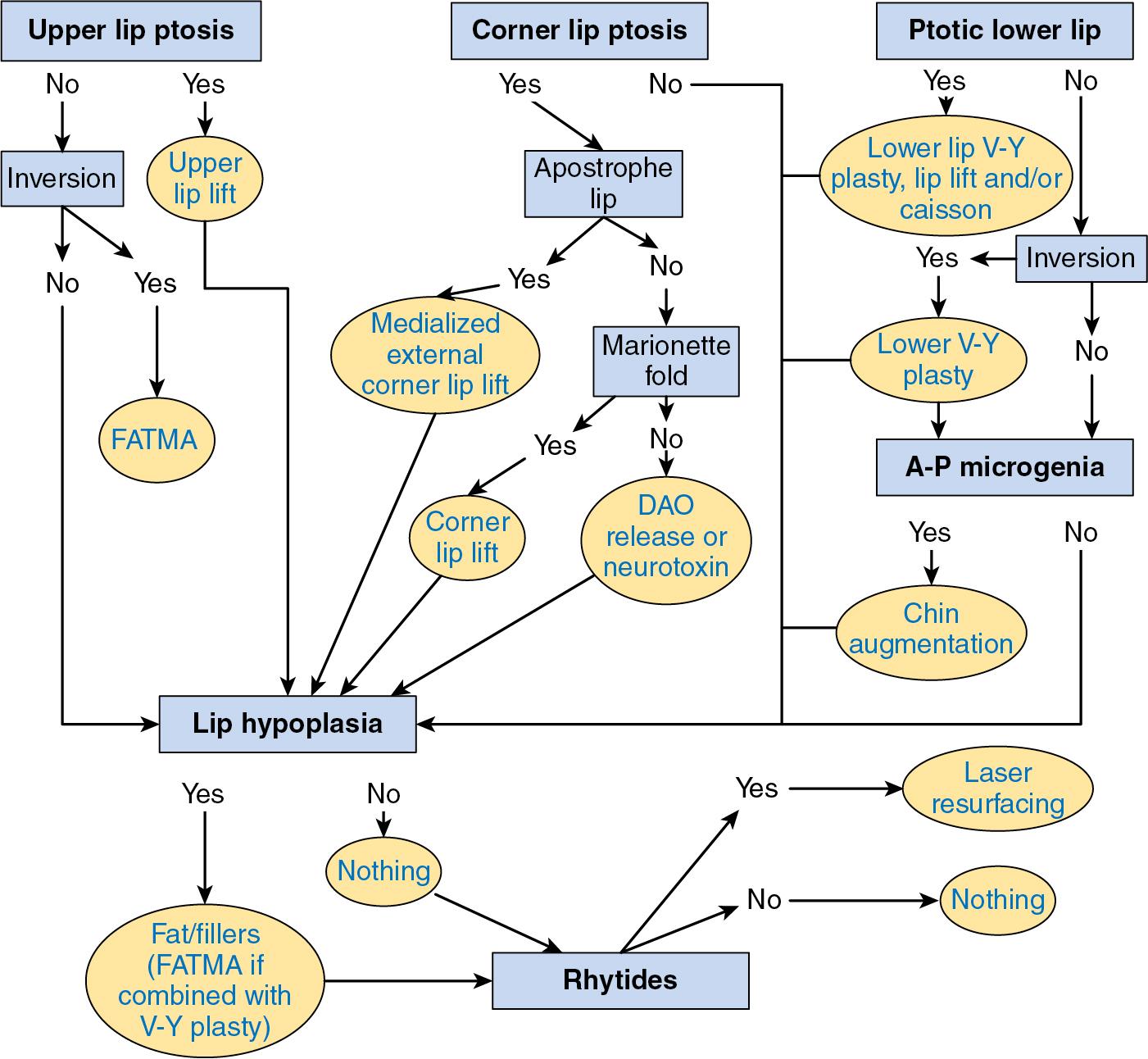
Become a Clinical Tree membership for Full access and enjoy Unlimited articles
If you are a member. Log in here